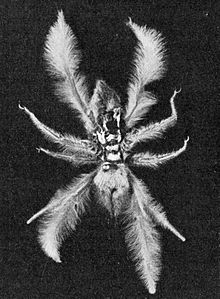
Aelurillus is a genus of spiders in the family Salticidae.

Plexippus is a genus of jumping spiders that was first described by Carl Ludwig Koch in 1846. It is considered a senior synonym of Hissarinus and Apamamia.

Toxophora is a genus of flies belonging to the family Bombyliidae (bee-flies). There are 47 described species, distributed throughout the world, although they are most abundant in Southwestern United States and western Mediterranean. World catalog of bee flies They are strange, stout, robust flies with a hunchbacked form, with a body length of 6–12 mm and wings 4 to 7.5mm. Most species are black with banding or spots.

Galeodes is a genus of solifuges or sun spiders. The nearly 200 species in this genus are found in northern Africa, southeastern Europe and Asia. Like other solifuges, they are mainly nocturnal and found in arid habitats. They often have long hairy appendages and are not as stout bodied or dark and contrastingly coloured as some other solifuges. Some Galeodes species are able to produce sounds by stridulation. These are usually raspy or hiss-like and may be imitations of the sounds of vipers, to serve a defensive function. As in other solifuges, mating involves the male depositing a spermatogonia that is manipulated into the female genital opening using their chelicera. The male strokes the female using the palps allowing her to be approached. Females will often feed on males before or after mating. The female then deposits the eggs in a burrow in soil and in some species guards them.

Galeodidae is a family of solifuges, first described by Carl Jakob Sundevall in 1833.

Zeria is a genus of solpugid camel spiders, first described by Eugène Simon in 1879.
Pterotricha is a genus of ground spiders that was first described by Władysław Kulczyński in 1903.
Hemiblossia is a genus of daesiid camel spiders, first described by Karl Kraepelin in 1899.
Biton is a genus of daesiid camel spiders, first described by Ferdinand Karsch in 1880.
Gluviopsis is a genus of daesiid camel spiders, first described by Karl Kraepelin in 1899.
Gluviopsona is a genus of daesiid camel spiders, first described by Carl Friedrich Roewer in 1933.
Karschiidae is a family of solifuges, first described by Karl Kraepelin in 1899.
Rhagoditta is a genus of rhagodid camel spiders, first described by Carl Friedrich Roewer in 1933.
Karschia is a genus of karschiid camel spiders, first described by Alfred Walter in 1889.
Galeodopsis is a genus of Galeodid camel spiders, first described by Aleksei Birula in 1903.
Eusimonia is a genus of karschiid camel spiders, first described by Karl Kraepelin in 1899.
Rhagodopa is a genus of rhagodid camel spiders, first described by Carl Friedrich Roewer in 1933.
Rhagodes is a genus of rhagodid camel spiders, first described by Reginald Innes Pocock in 1897.
Gylippus is a genus of gylippid camel spiders, first described by Eugène Simon in 1879.
Oparbella is a genus of solpugid camel spiders, first described by Carl Friedrich Roewer in 1934.






